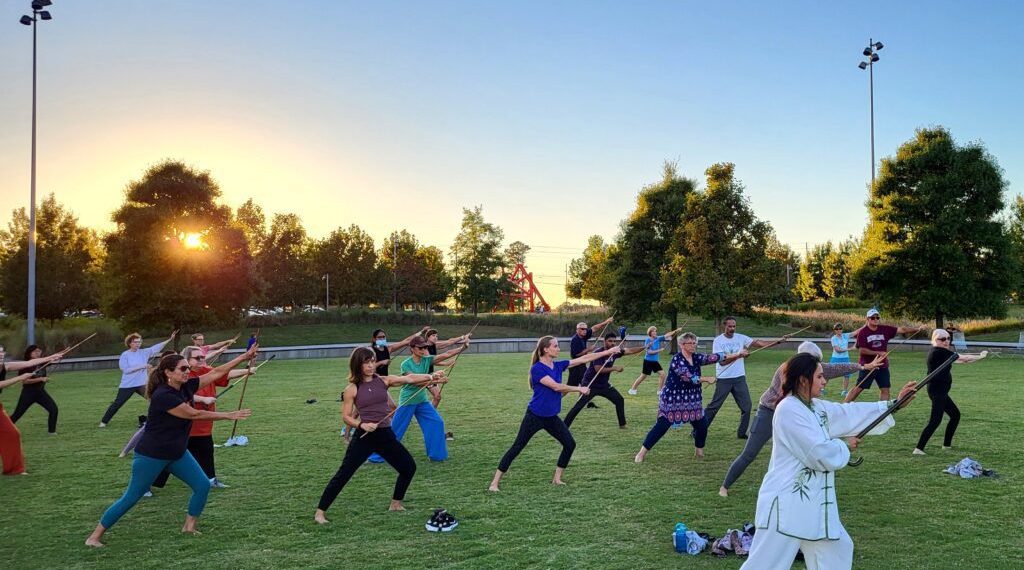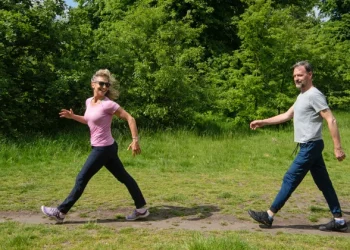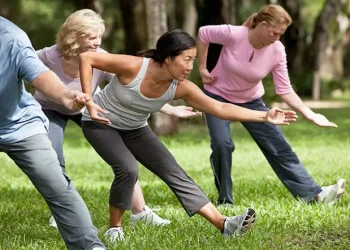In a world that rushes forward at breakneck speed, Tai Chi walking offers a profound counterpoint—a practice that transforms the simple act of walking into a moving meditation. This ancient Chinese practice, rooted in Tai Chi principles, combines physical movement with mental awareness to create a holistic exercise that benefits body, mind, and spirit. Whether you’re new to mindful movement or an experienced practitioner seeking to deepen your practice, Tai Chi walking provides an accessible yet infinitely refinable path toward greater balance, presence, and vitality.
Understanding Tai Chi Walking
Tai Chi walking, sometimes called Tai Chi walk meditation or walking qigong, applies the fundamental principles of Tai Chi to the act of walking. Unlike ordinary walking where we move unconsciously from point A to point B, Tai Chi walking emphasizes slow, deliberate movements coordinated with breath and cultivated awareness. Each step becomes an opportunity to practice rooting, weight shifting, and maintaining centeredness—core concepts in all Tai Chi practice.
The practice differs from standard Tai Chi forms in its simplicity and accessibility. While traditional Tai Chi involves learning complex sequences of movements, Tai Chi walking strips the practice down to its essential elements. This makes it an ideal entry point for beginners while offering seasoned practitioners a way to refine fundamental skills that underpin all Tai Chi movements.
Establishing Your Practice: The Foundation
Beginning a Tai Chi walking practice requires minimal equipment and no special location, yet establishing proper foundations ensures you’ll build sustainable habits and avoid common pitfalls.
Finding Your Space
Start by identifying where you’ll practice. An indoor hallway, outdoor path, or quiet room provides sufficient space. You need only fifteen to twenty feet of unobstructed area where you can walk back and forth comfortably. The surface should be level and safe, allowing you to focus inward rather than worrying about obstacles. Many practitioners find that practicing in the same location helps establish ritual and routine, though varying your environment can also deepen awareness as you adapt to different conditions.
Learning the Basic Form
The fundamental Tai Chi walk begins with proper stance. Stand with feet parallel and hip-width apart, knees slightly bent, and weight evenly distributed. Your spine should feel lengthened, as if suspended from above, while your shoulders relax downward and your tailbone releases toward the ground. This creates the characteristic Tai Chi posture—simultaneously rooted and buoyant.
To initiate movement, shift your weight completely onto one leg, allowing the other to become “empty” or weightless. Slowly lift the empty foot, keeping the knee bent, and place it forward with the heel touching first. As you roll through the foot from heel to toe, gradually shift your weight forward into the front leg. The rear leg then becomes empty, ready to step forward in turn.
Throughout this process, move with deliberate slowness. A single step might take ten to twenty seconds initially. This pace isn’t arbitrary—it allows you to feel the subtle mechanics of weight transfer, balance adjustment, and muscular engagement that normally occur unconsciously.
Coordinating Breath and Movement
Breathing forms the bridge between body and mind in Tai Chi practice. As you step forward, inhale naturally through your nose, allowing your lower abdomen to expand. As you complete the weight shift and settle into the new stance, exhale gently. Don’t force the rhythm; let breath and movement find their natural synchronization over time. Some practitioners prefer the reverse pattern—exhaling while stepping—so experiment to discover what feels most natural for your body.
Starting Small
Begin with just five to ten minutes of practice. This might seem brief, but the intense focus required in Tai Chi walking makes it more demanding than it appears. Starting conservatively prevents fatigue and frustration while allowing your body to adapt to the unique physical demands of such slow, controlled movement.
Maintaining Consistency: Building the Habit
Establishing a regular practice proves more challenging than learning the movements themselves. Life’s demands constantly compete for our time and attention, making consistency the real test of commitment.
Creating Your Ritual
Schedule your practice at the same time each day whenever possible. Many practitioners favor early morning when the mind is fresh and the day’s distractions haven’t yet accumulated. Others prefer evening practice as a way to decompress from daily stress. The “best” time is whichever time you’ll actually practice consistently.
Develop pre-practice rituals that signal to your mind and body that it’s time to shift into practice mode. This might include changing into comfortable clothing, playing soft music, or spending a moment setting an intention for your practice. These small ceremonies create psychological momentum that makes starting easier.
Tracking Progress Mindfully
While Tai Chi emphasizes being present rather than goal-oriented, maintaining some form of practice log can support consistency. Note the date, duration, and perhaps a brief observation about your practice. Did you notice improved balance? Greater mental clarity? Physical restlessness? This record becomes both motivation and documentation of your journey, revealing patterns and progress that might otherwise go unnoticed.
Joining a Community
Connecting with other practitioners, whether through local classes, online forums, or practice groups, provides accountability and inspiration. Sharing experiences normalizes the challenges everyone faces and offers practical solutions you might not discover alone. Even if you practice solo most days, periodic group sessions can reignite motivation and correct technique drift.
Embracing Imperfection
Some days your practice will feel transcendent; others will feel like merely going through the motions. Both experiences are valuable. Consistency means showing up regardless of how you feel or how “successful” any individual session seems. The practice works on you even when you feel nothing is happening, like water slowly smoothing stone.
Deepening Your Practice Over Time
As weeks become months and months become years, Tai Chi walking evolves from a series of mechanical movements into something more nuanced and profound.
Refining Physical Alignment
With established consistency, turn attention to subtle refinements. Notice the precise moment when weight fully transitions from one leg to the other. Explore different speeds—perhaps slowing your walk to one step per minute or experimenting with slightly faster variations. Investigate how small adjustments in hip rotation, foot angle, or hand position affect your balance and energy flow.
Many practitioners discover that after months of practice, their normal walking changes. They move with greater ease, better posture, and increased awareness—evidence that the practice is integrating beyond the formal session.
Expanding Awareness
Early practice naturally focuses on physical mechanics, but deepening practice expands awareness to include increasingly subtle phenomena. Begin noticing the space around your body as you move through it. Feel air against your skin. Perceive the room’s acoustic quality. Register subtle shifts in mental state as you practice.
This expanded awareness represents a key transition from Tai Chi walking as exercise to Tai Chi walking as meditation. Your body continues moving, but your primary focus shifts to the quality of consciousness itself—open, clear, and present.
Integrating Visualization
Advanced practitioners often incorporate traditional Tai Chi imagery into walking practice. Visualize roots extending from your feet deep into the earth with each step. Imagine your spine as a bamboo stalk—flexible yet upright. Picture energy rising from the ground up through your legs, circulating through your torso, and returning to the earth. These mental images aren’t mere fantasy; they subtly influence physical alignment and movement quality in ways that verbal instructions cannot.
Exploring Variations
As your foundation solidifies, explore variations that challenge and expand your practice. Try walking backward, maintaining the same slow control and awareness. Practice in different environments—grass, sand, gentle slopes. Experiment with arm movements, allowing hands to float gently or incorporating simple Tai Chi hand forms. Each variation provides new insights and prevents practice from becoming mechanical repetition.
Overcoming Common Challenges
Every practitioner encounters obstacles. Recognizing common challenges and understanding effective responses makes the difference between abandoning practice and integrating it permanently into your life.
Physical Discomfort
The slow, controlled movements of Tai Chi walking often reveal weaknesses or imbalances in your body. Knees may ache, thighs burn, or feet cramp. This discomfort typically indicates areas needing strengthening and increased flexibility. Back off slightly if pain is sharp or concentrated in joints, but accept the muscular effort required to hold positions slowly. The discomfort usually diminishes as your body adapts.
If problems persist beyond a few weeks, consult a qualified Tai Chi instructor or physical therapist to ensure proper alignment and rule out underlying issues.
Mental Restlessness
Many beginners underestimate how challenging it is to maintain focus during such simple, repetitive movement. The mind rebels, generating compelling thoughts about everything except the present moment. This isn’t failure—it’s the practice revealing your mind’s habitual patterns.
When you notice distraction, simply note it without judgment and return attention to physical sensation: the feeling of your foot touching ground, the sensation of weight shifting, the rhythm of your breath. You’ll do this hundreds of times each session. This returning is the practice.
Impatience with Progress
Tai Chi walking develops qualities that resist measurement: balance, awareness, inner calm. Without obvious milestones, you may question whether you’re “getting anywhere.” Remember that this practice cultivates ways of being rather than achieving specific goals. The benefits accumulate gradually and express themselves in unexpected ways—greater emotional resilience, improved sleep, enhanced body awareness in daily activities.
Trust the process and maintain consistency. The practice works whether you perceive progress or not.
Time Constraints
Modern life constantly demands our time, making regular practice feel impossible. The beauty of Tai Chi walking is its flexibility. Ten minutes provides meaningful practice. Even five minutes of mindful walking shifts your state more than thirty minutes of distracted movement.
Consider integrating micro-practices throughout your day: walk mindfully from car to office, practice during lunch break, or do a brief session before bed. These fragments accumulate, maintaining your connection to practice even during busy periods.
Isolation and Self-Doubt
Practicing alone, without immediate feedback, sometimes breeds uncertainty about whether you’re doing it “right.” While some self-correction naturally occurs through practice, periodic guidance from an experienced teacher provides invaluable course corrections and encouragement.
Seek out workshops, classes, or even online instruction occasionally. A few sessions with a qualified teacher can catalyze months of self-guided progress and reassure you that your practice is developing appropriately.
The Path Forward
Tai Chi walking offers a lifetime of exploration wrapped in simple, accessible practice. It asks only that you walk slowly, breathe naturally, and pay attention. From this straightforward beginning emerges a sophisticated practice that integrates body, mind, and spirit.
The journey unfolds in stages: establishing foundations, building consistency, deepening awareness, and overcoming inevitable challenges. Yet it’s not truly linear. You’ll circle back to beginnings with fresh eyes, discover new depths in familiar movements, and encounter both breakthrough moments and frustrating plateaus.
What matters most is continuing to show up, placing one mindful foot in front of the other, trusting that each step—however imperfect—contributes to transformation occurring beneath conscious awareness. In this way, Tai Chi walking becomes not just a practice you do, but gradually, who you are: someone who moves through life with greater awareness, balance, and grace.
Begin today. Find a quiet space, stand with attention, and take your first slow, conscious step. The journey of a thousand miles begins here, one mindful step at a time.






